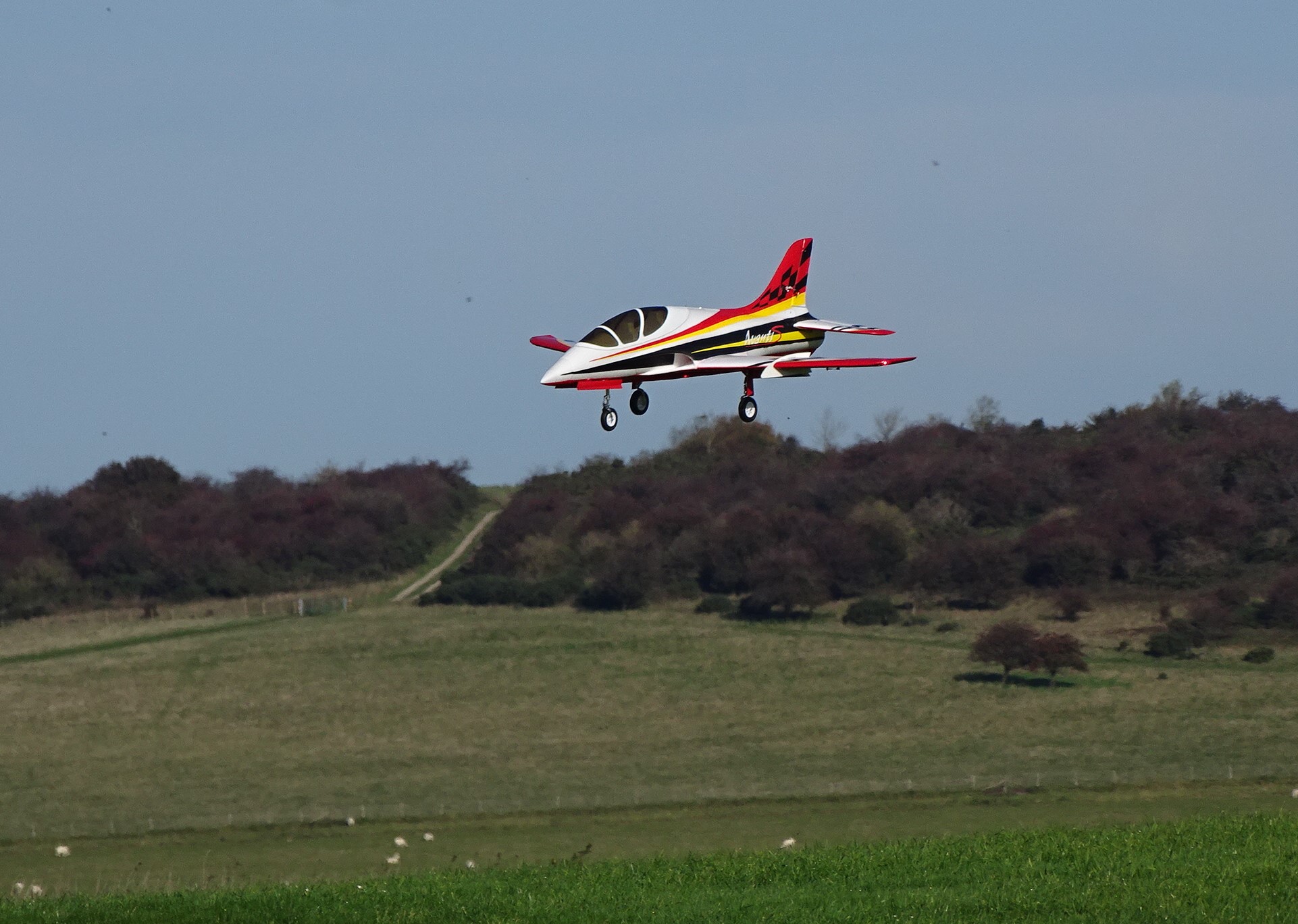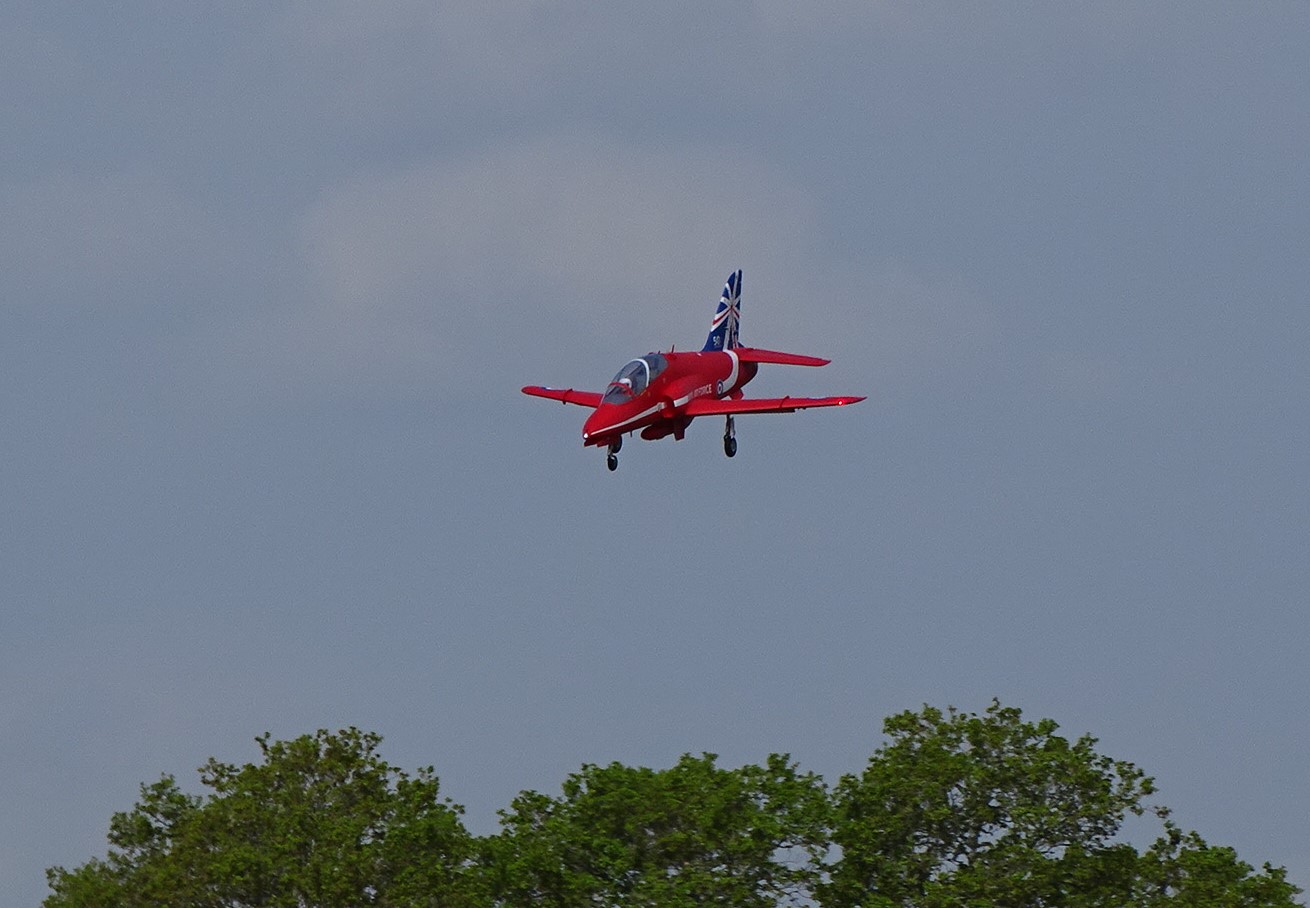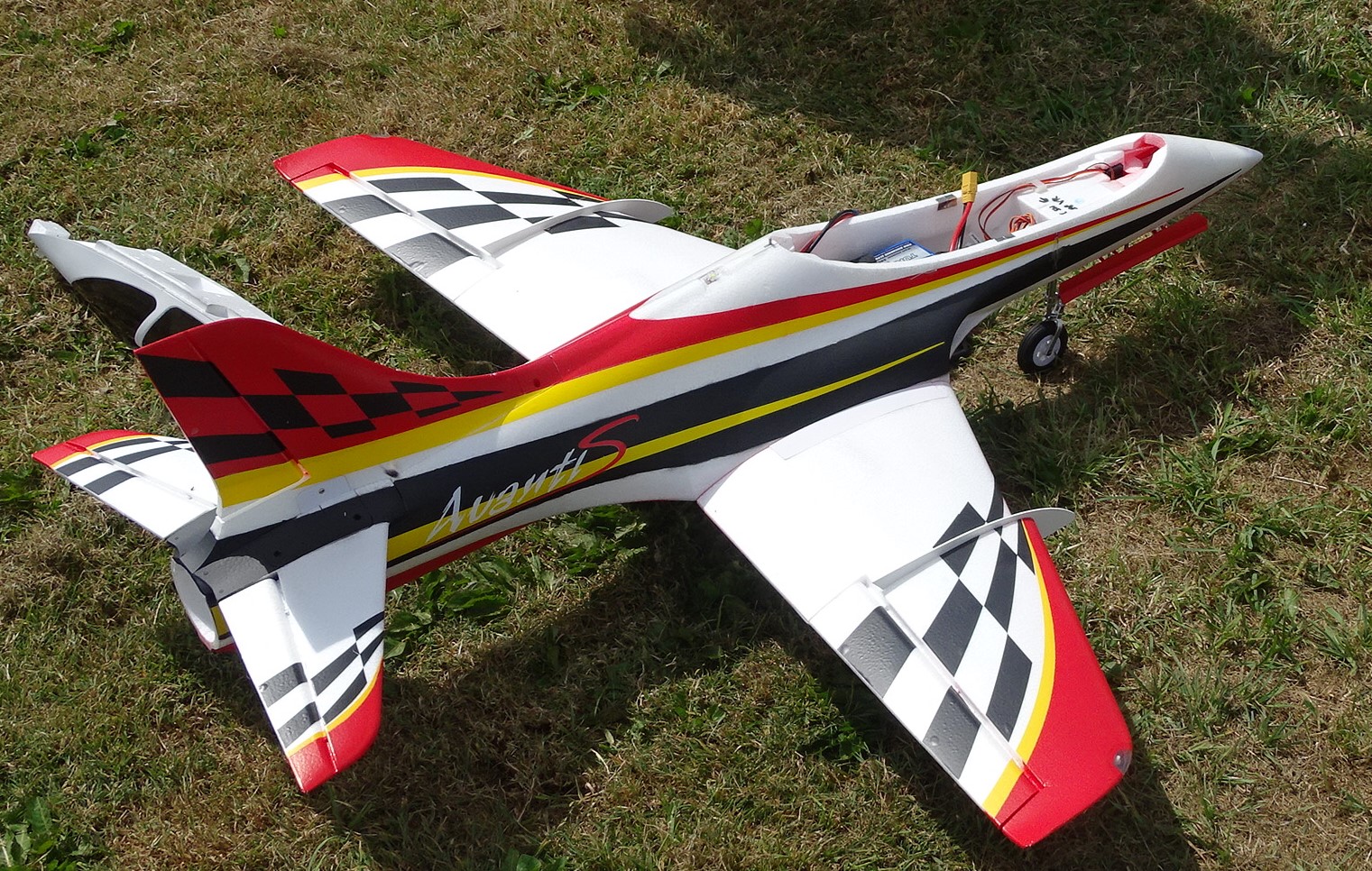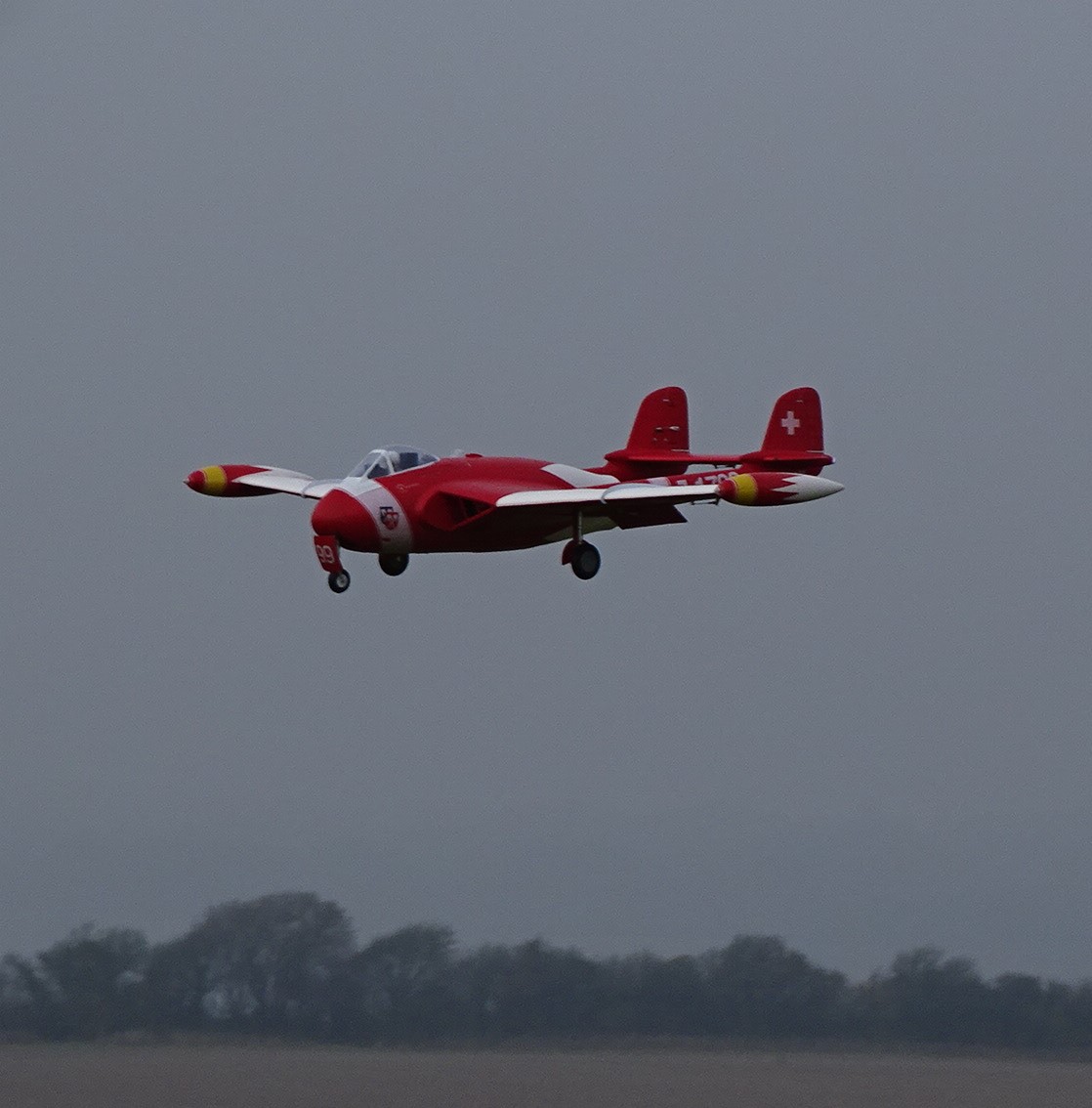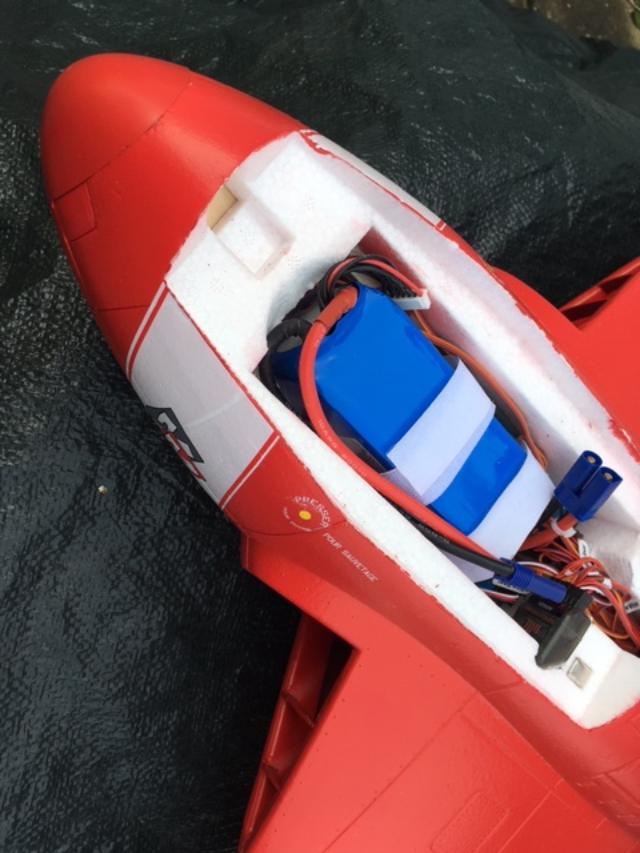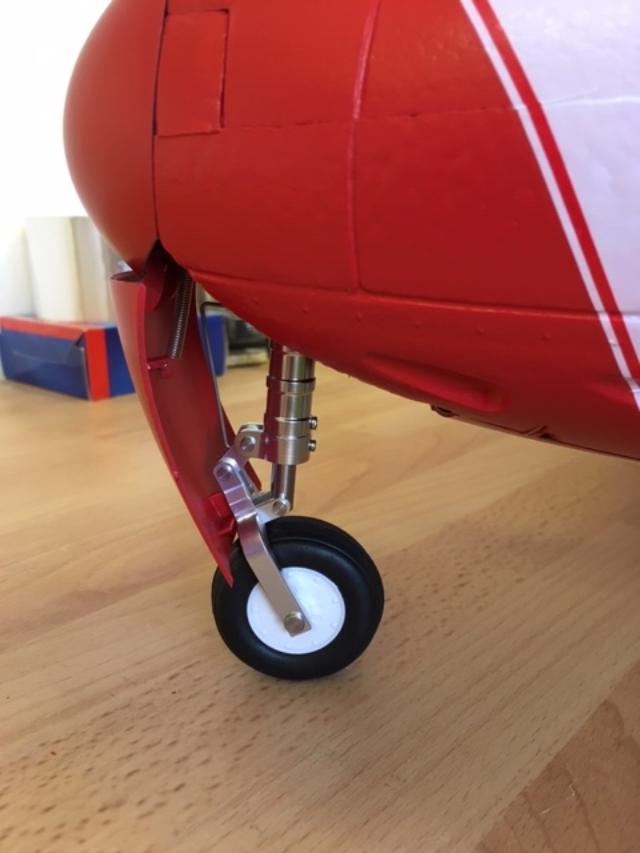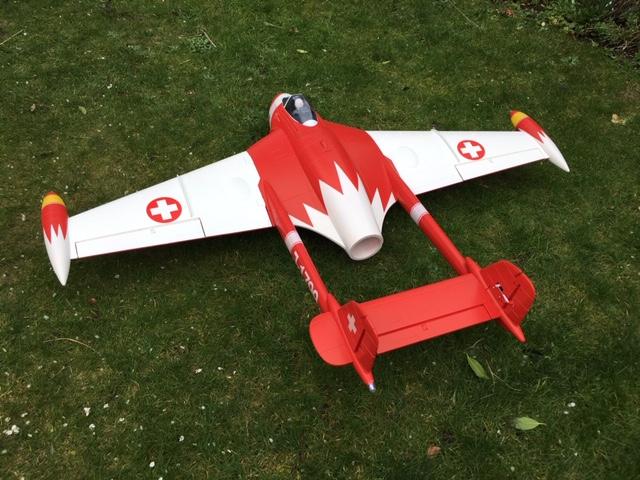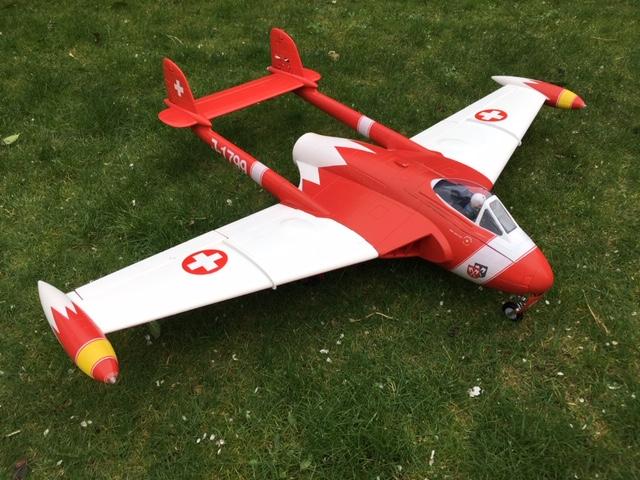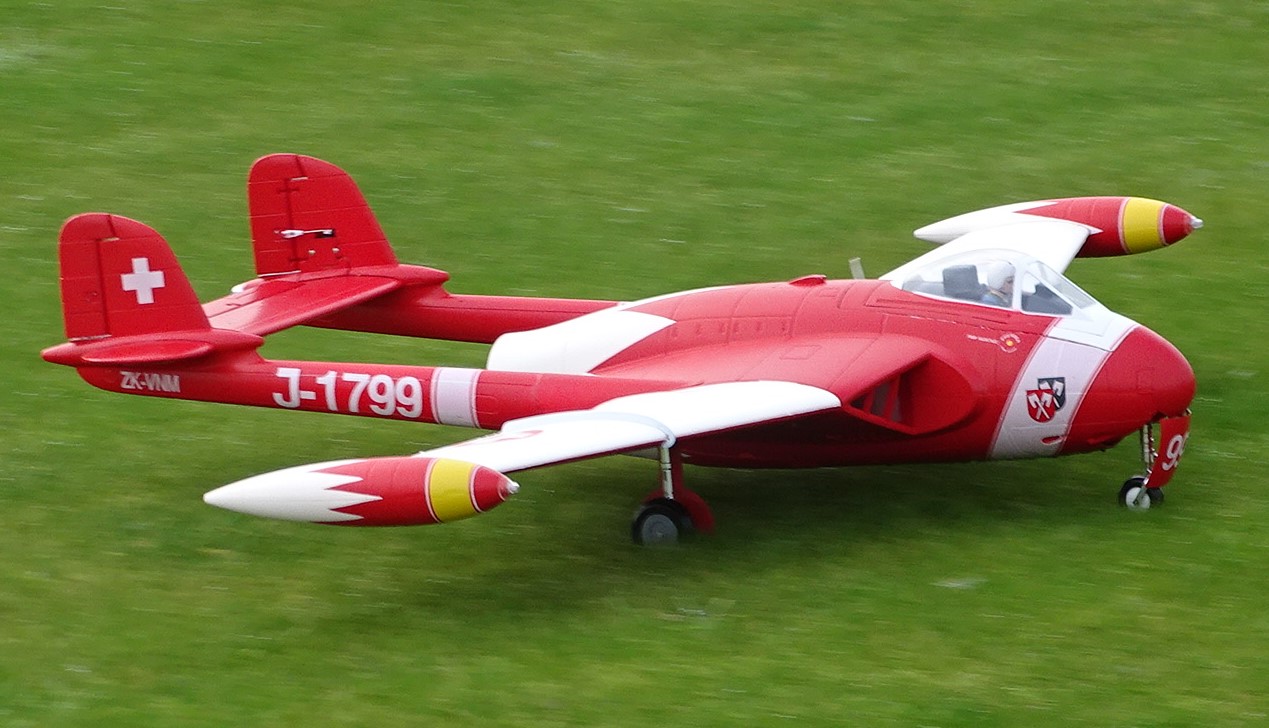|
Christchurch and District Model Flying Club |
|
EDF
Those of you who a few years back attended my talk/slide show celebrating C&DMFC’s Jubilee, will recall my mention of Jim Ruffell’s experiments way back in 1992 with an EDF own-design Mig15, a home-made fan unit, and a rotary clothes line! Back then there were few, if any, commercial fan units available, no Lipo’s, and no brushless motors. To get a viable fan unit to work was a major achievement, and to get it to successfully fly an EDF jet was nothing short of a miracle. But fly it did (I still have the video evidence), albeit not for very long and all the time sounding like a demented hair dryer! Now fast forward over 25 years – how times have changed! Nowadays it is possible to buy any number of well-sorted foamie jets that come complete with powerful fan units and brushless motors, all powered by lightweight Lipo cells. Moreover, most come complete with electric retracts and flaps. Not only do these jets have thrust in abundance, the modern fan units (especially those with 12 blades) make a pretty realistic jet noise too. The only thing missing is the smell of kerosene! All sounds pretty good so far, but there is a down side! Don’t expect flight times that are comparable with a propeller driven model. Whereas you might get 8 minutes from a propeller model, expect no more than about 4 minutes maximum from an EDF, which is a shame because these things are so much fun to fly and look so realistic in the air that you won’t want it to stop. It goes without saying then that a pretty hefty investment in batteries is also required! Jets are also quite addictive (Trevor Hewson has already succumbed!), and once hooked you’ll probably want more. You have been warned! My interest in EDF’s was aroused when I discovered that most modern EDF’s can handle grass strips, provided that such strips are reasonably well mown and maintained. Whilst Strawberry Field is, EDF’s don’t much like holes and big bumps in the ground on take-off. They are also very fast and use a lot of sky very quickly once airborne. Although I have flown an EDF successfully at Strawberry Field, it is for these reasons that I now prefer to fly them somewhere a little more suitable. Noise is no longer an issue though, since most modern EDF’s are not particularly noisy – the days of sounding like demented hair dryers are long gone. I now have three EDF’s (I told you they are addictive!), all of which are an absolute delight to fly, and it is my pleasure to share with you here in words and pictures some of their details and my experiences so far, in the hope that they might inspire you to become jet-jockeys too: FMS Red Arrows Hawk This was my first EDF model. Before buying, I looked at both the Freewing and FMS versions, but decided to go for the FMS version because I felt that it looked a little more scale like and also the u/c was infinitely more appealing. I’ve not been disappointed. The level of scale detail for a foam model is quite remarkable, and several people who’ve seen it have questioned if it really is made of foam! Assembly is a doddle - four screws secure the one-piece wing, two secure the horizontal stabiliser, and other parts just slot into place – apart from a few minor tiny scale details, no gluing is required! Install your chosen Rx, connect everything up and you’re pretty much ready to go. Fully assembled, the Hawk will easily fit into a small car, which is handy because connecting up the wing wiring and tucking the wiring away so that the wing seats neatly is a bit of a fiddle. For this reason I tend to keep my Hawk fully assembled. As with nearly all foam jets, spare parts are readily available should the worst happen. I also have several spare parts should any of you be in need! Take-Off: Full power together with a little flap will see the Hawk hurtling down the runway as straight as an arrow, little or no correction necessary. Take a second now to imagine that wonderful jet whoosh! Give it plenty of time to build up speed and then, if necessary, squeeze a little bit of up elevator to rotate and lift off. Get the gear and flaps up as soon as possible after lift-off, and start easing back on the power to conserve the battery. Flight: The Hawk will fly easily and still plenty fast enough on half throttle or even less, but careful throttle and energy management are the key to maximising flight time. The Hawk is not a difficult aircraft to fly for anyone with a bit of experience, and the controls seem nicely harmonised. I usually fly with ailerons and elevator on the lowest recommended rates, which are more than adequate. Remember though, this is a jet, so it is necessary to keep some power on at all times. Unfortunately, all too soon though, your timer will be telling you it’s time to land. Landing: This is probably the most difficult of all manoeuvres with a tricycle u/c jet. First thing to remember is that you cannot cut and glide. Second thing to remember is to use full flap so that the final meeting of wheels with ground is not too fast. Fortunately with the Hawk, there is no discernible pitch change when the flaps and u/c are deployed, so no need for any flap/elevator mixing. However, it is important to power up a bit when lowering the flaps and u/c, as the extra drag is really noticeable. As with any landing, the key to success is getting the approach right and presenting the model on finals at the right height, attitude, and speed. The difficult bit is just before touch down, judging the precise moment at which to flare, so that the mains contact first and the model doesn’t bounce back in the air. No amount of words will tell you how to do this, just practice, practice, practice! FMS Hawk Basic Specification: Wingspan: 1042mm (One-piece wing) Length: 1226mm Flying Weight: 2500g approx. Power System: 3270 – Kv1930 inrunner ESC: Predator 100A with 8A BEC EDF Unit: 80mm 12-Blade FMS Fan Required Battery: 6S 4000mAh 35C with EC5 Connector Required Radio: 6CH min. Supplied with metal-gear servos, all-metal shock absorbing electric retracts, and LED lighting system. RRP (Feb 2020): 360GBP (PNP) Freewing Avanti S This was my second EDF model and came about largely as a result of having seen an Avanti fly at a time when I was looking for a model that had slightly larger diameter wheels than the Hawk. Don’t get me wrong, the Hawk is fine off short grass, but I felt that larger wheels would be better for those times when the grass is more ‘draggy’. The Avanti is a little more ‘foamie’ than the Hawk, but nevertheless the finish is still very acceptable. Remember too that this is a ‘sport’ jet, not a ‘scale’ jet. It is a seriously good looking model nonetheless. Like the Hawk, assembly is quick and easy, but for some unknown reason Freewing have chosen to leave the buyer to glue the canopy to the foam canopy frame. Not difficult in itself, but could be an irritation for those perhaps not quite so skilled in the art! Nice features of this model are separate port and starboard wings (each secured with just two screws), installed ribbon cables so that there is just one electrical connection to be made between each wing and the fuselage, and a removable nose cone which is held on with powerful magnets. This feature I find particularly handy for transportation and storage. My version of the Avanti (the red one) comes with a 9-Blade fan (note that the yellow version is said to come with a 12-Blade fan). Initially, I was a little concerned that this 9-Blade fan might not sound quite as good as a 12-Blade fan, but my concerns were unfounded – it sounds superb! In my experience, most foam EDF’s are extremely well-designed and well-sorted machines, but one area that lets many of them down is the fit of the u/c doors. In this regard, the nose wheel doors on the Avanti is the one big disappointment. Both Trevor and I have modified ours by adding a stiffening bar on the inside of each door which helps to improve the situation, but it would have been so easy for Freewing to have designed the door mouldings in such a way that there was no need to have to make this modification! Take-Off: Is pretty much the same as for the Hawk, although flaps seem to make less of a difference. The Avanti seems equally happy taking off with or without flaps, but either way it is usually necessary squeeze a little bit of up elevator to rotate and lift off. Flight and Landing: Again, pretty much the same as the Hawk. Like the Hawk, the Avanti is not a difficult aircraft to fly for anyone with a bit of experience, and the controls are likewise nicely harmonised. As with the Hawk, I usually fly with ailerons and elevator on the lowest recommended rates, which again are more than adequate. Like the Hawk, there is also no discernible pitch change when the flaps and u/c are deployed, so again no need for any flap/elevator mixing. Freewing Avanti S Basic Specification: Wingspan: 1236mm Length: 1300mm Flying Weight: 2600g approx. Power System: 3658 – Kv1857 inrunner ESC: Hobbywing 100A with 5A BEC EDF Unit: 80mm 9-Blade Freewing Fan Required Battery: 6S 4000mAh 35C with EC5 Connector Required Radio: 6CH min. Supplied with metal-gear servos, all-metal shock absorbing electric retracts, and LED lighting system. RRP (Feb 2020): 379 Euros (PNP), 299 Euros (ARF PLUS)
Freewing Venom My other EDF jet is a Freewing Venom. Actually, although marketed as a “Freewing” model, it is in fact a “Ready2Fly” model, which explains why you will find differences in this model when compared with the true Freewing range. The most significant difference I have found is that there are no ribbon cables as on the Avanti, so instead of just one electrical connection to be made between each wing and the fuselage, there are four, which is a bit of a pain. Also, this is not a simple screw together model like the Hawk and the Avanti – this one requires quite a bit of gluing and alignment. It is not difficult, but requires more care. Chinese glue is provided in the kit, but I have my doubts about its effectiveness (don’t ask me how I know!), so I substituted my usual 5 min. epoxy. When I was considering my purchase of the Avanti, I was torn between the Avanti and the Venom – there is a certain attraction about twin boom aircraft, and the Venom is quite a bit larger than both the Hawk and the Avanti. With older tired eyes, I figured that a larger fast jet would be easier to see than a smaller fast jet. In the end though I went for the Avanti, but my love affair with the Venom would not go away, so eventually I ended up with them both! Unlike the Hawk and the Avanti, which are powered by 80mm fan units, the Venom is powered by a 90mm fan unit. This fan is a 12-Blade unit and probably makes the best jet noise of them all. Although this is the largest of my EDF jets, it has by far the most restricted battery space. (And very neat UC retracts and doors - well worth obsessing over, although I cast no nasturtiums - Ed) I use Optipower Ultra 6S 4000 50C Lipos (Length: 140mm, Width: 50mm, Height: 42mm, Weight: 668g) in all three jets. These fit easily in the Hawk and the Avanti (there are acres of room in their battery bays), but are a real tight fit in the Venom. I have read of people using higher capacity cells in the Venom, but I struggle to see how they accommodate them! Using my Optipower cells, the Venom also requires about 60g of lead in the nose to bring the CG to the correct position. In the Hawk and the Avanti there is room to move the battery about, so no need for any additional nose weight. One strange thing about the Venom is that there are two LED’s mounted in the underside of the canopy base. I can only imagine that these are supposed to somehow illuminate the pilot’s instrument panel. Perhaps they do when it’s pitch black, but in daylight they do absolutely nothing! Furthermore, plugging them in just hinders canopy removal, so I have ignored and removed these pointless items! Take-Off: This is the easiest of all three models to take off. Basically, you just line it up, open the tap, and let the model do the rest. I have watched videos of this before, but am still surprised to find that this really is all you need to do. I have also seen a video in which one of these takes off from wet grass with its u/c retracted. Proof, if any were needed, that there is plenty of thrust available! Flight: If I had written this a few weeks ago, I would have said that this model is a real pussycat to fly …….. However, I was recently caught out by a sudden and quite vicious tip stall from which the Venom showed no desire whatsoever to recover. This was all the more peculiar because it had never before ever shown any inclination to tip stall. At the time, I was admittedly making a downwind turn on relatively low power (but not at what I thought was unusually low speed), so perhaps its previous benign behaviour had lulled me into a false sense of security - who knows? This model is fitted with tip tanks – does anyone know if these have any influence on tip stalling? Whatever, just in case, I have made a note to self to keep the power and speed on at all times! At least when a ‘foamie’ comes to grief it only hurts the wallet rather than the heart! Fortunately, spare parts are readily available, and I am pleased to report that my Venom is already ready to take to the air again. Landing: Of the three models, this is probably the most difficult of all to land nicely! I think this is for two reasons. Firstly, it floats on quite well, making it difficult to judge the exact moment at which to flare, and secondly, the u/c is quite short, which results in more ‘ground effect’ close to the point of touch down. For all that, the Venom is still a super model to fly, and one that (because of its size) has great presence in the air - I love it. Freewing (Ready2Fly) Venom Basic Specification: Wingspan: 1500mm Length: 1100mm Flying Weight: 2500g approx. Power System: 3748 – Kv1650 inrunner ESC: Hobbywing 130A with 8A UBEC EDF Unit: 90mm 12-Blade Freewing Fan Required Battery: 6S 4000mAh 40C with EC5 Connector Required Radio: 6CH min. Supplied with metal-gear servos, all-metal shock absorbing electric retracts, and LED lighting system. RRP (Feb 2020): 435 Euros (PNP), 349 Euros (ARF PLUS) My Hawk came from Sussex Model Centre, and my Avanti and Venom from Motion RC EU. I have found that both provide really prompt and excellent service. Thoroughly recommended. Now what should I go for next? Well, Freewing have recently brought out a twin-engined airliner designated an AL37, which for all the world looks like a Boeing 737 Max 8 …… perhaps not then!! |
|
[Home] [Chairman's Chatter] [Beginnings] [EDF 1] [EDF 2] [EDF 3] [Avro Lincoln] [Burn] [Book Review] [Tailpiece] |
